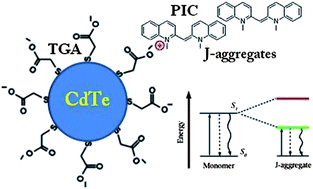Hybrid organic/inorganic semiconductor nanostructures with highly efficient energy transfer
Abstract
Using electro-static

* Corresponding authors
a Centro de Fisica de Materiales (MPC, CSIC-UPV/EHU) and Donostia International Physics Center (DIPC), Paseo Manuel de Lardizabal 5, Donostia-San Sebastian, Spain
b CIC nanoGUNE Consolider, Tolosa Hiribidea 76, Donostia-San Sebastian, Spain
c Physical Chemistry, TU Dresden, Bergstrasse 66b, Dresden, Germany
d
IKERBASQUE, Basque Foundation for Science, Bilbao, Spain
E-mail:
yury.rakovich@ehu.es
Using electro-static

 Please wait while we load your content...
Something went wrong. Try again?
Please wait while we load your content...
Something went wrong. Try again?
D. Savateeva, D. Melnikau, V. Lesnyak, N. Gaponik and Y. P. Rakovich, J. Mater. Chem., 2012, 22, 10816 DOI: 10.1039/C2JM30917C
To request permission to reproduce material from this article, please go to the Copyright Clearance Center request page.
If you are an author contributing to an RSC publication, you do not need to request permission provided correct acknowledgement is given.
If you are the author of this article, you do not need to request permission to reproduce figures and diagrams provided correct acknowledgement is given. If you want to reproduce the whole article in a third-party publication (excluding your thesis/dissertation for which permission is not required) please go to the Copyright Clearance Center request page.
Read more about how to correctly acknowledge RSC content.
 Fetching data from CrossRef.
Fetching data from CrossRef.
This may take some time to load.
Loading related content
